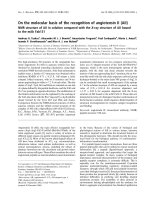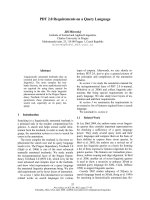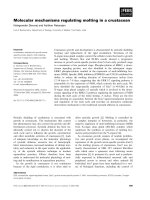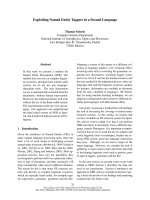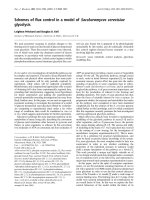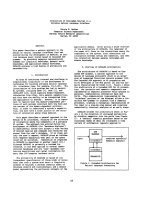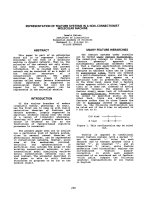báo cáo khoa học: "Multiple cavernous malformations presenting in a patient with Poland syndrome: A case report" pptx
Bạn đang xem bản rút gọn của tài liệu. Xem và tải ngay bản đầy đủ của tài liệu tại đây (883.23 KB, 4 trang )
CAS E REP O R T Open Access
Multiple cavernous malformations presenting in a
patient with Poland syndrome: A case report
Karlo J Lizarraga and Antonio AF De Salles
*
Abstract
Introduction: Poland syndrome is a congenital disorder related to chest and hand anomalies on one side of the
body. Its etiology remains unclear, with an ipsilateral vascular alteration (of unknown origin) to the subclavian
artery in early embryogenesis being the currently accepted theory. Cavernous malformations are vascular
hamartomas, which have been linked to a genetic etiology, particularly in familial cases, which commonly present
with multiple lesions. Our case report is the first to describe mul tiple cavernous malformations associated with
Poland syndrome, further supporting the vascular etiology theory, but pointing to a genetic rather than a
mechanistic factor dis rupting blood flow in the corresponding vessels.
Case presentation: A 41-year-old Caucasian man with Poland syndrome on the right side of his body presented
to our hospital with a secondary generalized seizure and was found to have multiple cavernous malformations
distributed in his brain, cerebellum, and brain stem, with a predominance of lesions in the left hemisphere.
Conclusion: The distribution of cavernous malformations in the left hemisphere and the right-sided Poland
syndrome in our patient could not be explained by a mechanistic disruption of one of the subclavian arteries.
A genetic alteration, as in familial cavernous malformations, would be a more appropriate etiologic diagnosis of
Poland syndrome in our patient. Further genetic and pathological studies of the involved blood vessels in patients
with Poland syndrome could lead to a better understanding of the disease.
Introduction
Poland syndrome is a congenital disorder of unknown
etiology characterized by ipsilateral hand and chest wall
anomalies, including hypoplasia or absence of the breast
and pectoral muscles [1]. Accepted theories point to an
early deficit of blood flow to the distal limb, the pectoral
region, and even the brain stem via the subclavian artery
during week six of gestation [2]. Its etio logy to date has
involved two hyp otheses. One proposes that the underly-
ing ribs on the affected side grow too quickly in a forward
growth plane and thus reduce blood flow in the arteries.
Another proposes that a malformation of the embryonic
blood vessel serving the pectoralis muscle and t he arm
and/or hand on the same side of the body limits blood
flow to these structures. Final proof is lacking, and no
genetic evidence exists [2-4].
One case report described a patient with Poland-
Möbius syndrome (which includes bilateral abnormalities
of the oculomotor and faci al cranial nerves) who
presented with one cavernous malformation (CM) that
was causing generalized seizures, which resolved after its
surgical resect ion [5] . CMs are low-flow vascular hamar-
tomas characterized by endothelium-lined sinusoidal
chambers that lack the other mural elem ents of matur e
vascular structures and a distinctive multi-lobulated,
“multi-berry” appearance on MRI sca ns [6,7]. They can
be asymptomatic in up to 40% of patients or may mani-
fest as seizures or neurological deficits [6,7]. Sporadic
and familial forms of CMs have been described, with the
latter comprising at least 6% of all cases [6,8]. Multiple
lesions are common in familial forms [8,9]. Hereditary
forms of cerebral CMs are caused by mutations in one of
three g enes, KRIT1 (CCM1), CCM2 (MGC4607), and
PDCD10 (CCM3),thatmayhavearoleinthegenesisof
vascular endothelial cells. Their critical importance to
lesion develo pment is underlined by the observation that
at least one of the CCM genes is mutated in most familial
* Correspondence:
Division of Neurosurgery, David Geffen School of Medicine, University of
California at Los Angeles, 10945 Le Conte Avenue, Room 2120, Los Angeles,
CA 90095, USA
Lizarraga and De Salles Journal of Medical Case Reports 2011, 5:469
/>JOURNAL OF MEDICAL
CASE REPORTS
© 2011 Lizarraga and De Salles; licensee BioMed Central Ltd. This is an Open Access article distributed under the terms of the Creative
Commons Attribution License ( which permits unrestricted use, distribution, and
reproduction in any medium, provided the original work is properly cited.
CMs [10-12]. The association of Poland syndrome with
multiple CMs described in our patient offers support to
the vascular theory as the underlying mechanism for this
pathological entity, but pointing to a genetic rather than
a mechanistic origin of the proposed vascular disruption.
Case presentation
A 41-year -old Caucasian man was sleeping when he sud-
denly experienced tonic movement of the right upper
limb followed by loss of consciousness and clonic move-
ments of his four extremities, all of which lasted approxi-
mately one minute and was s elf-limited. Our review of
his symptoms was negative, including headaches and
other neurologic symp toms or signs. H is medical history
included hypertension and Poland syndrome. His mother
had had chronic obstructive pulmonary disease and had a
heart attack at age 64, which caused her death. The rest
of the patient’s family history was negative for neurologic
or vascular alterations.
A physical examination revealed the absence of his right
breast and right pectoralis major muscles (Figure 1A) and
right-handed symbrachydactyly, status post-multiple
corrective surgeries (Figure 1B), corresponding to Poland
syndrome. His neurologic al examination results were
within normal limits. MRI studies showed multiple cere-
bral CMs, with the largest one, measuring 15.8 mm ×
9.3 mm, located in the left frontal p ole cortical region,
with evidence of recent hemorrhage (Figure 2). Two other
CMs located in the right and l eft parietal lobes also
showed evidence of bleeding (Figures 3A and 3B). The
majority of the CMs were located in the left hemisphere
(Figure 3B). Multiple other cerebellar and brain stem CMs
were also noted (Figures 3C and 3D).
The patient presented t o our hospital to discuss the
possibility of undergoing stereotactic radiosurgery for
treatment of the CMs. He had already been started on
levetiracetam 75 mg twice daily, which led to good sei-
zure control. Thus, electroencephalographic monitoring
and/or telemetry to detect the seizure origin localization,
continuing medical therapy, and observation were
recommended at that point.
Conclusion
While the pathogenesis of cerebral CMs on a g enetic
basis is starting to b e better understo od, the etiology of
Poland syndrome remains uncertain, with an ipsilateral
vascular alteration (of unknown origin) to the subclavian
artery in early embryogenesis being the currently
accepted theory [2,3]. We present the first case report in
the literature describing a patient with multiple CMs
associated with Poland syndrome, providing further evi-
dence in favor of a vascular disruption during early
angiogenesis as its possible etiology.
Our patient presented to our hospital with a secondary
generalized seizure, and the corresponding imaging stu-
dies showed multiple CMs in his brain, brain stem, and
cerebellum. Three CMs showed signs of hemorrhage and
it could not be ascertained which one caused his seizure.
Thus, we suggested that specialized imaging studies be
obtained for seizure localization. If the superficial frontal
lesion correlated with the seizure origin, the patient
would benefit from its surgical resection; meanwhile,
since the seizures were being a ppropriately controlled
with medication, observation was recommended.
Interestingly, the majority of lesions in our patient
were found to be located in the left cerebral hemisphere,
Figure 1 Features corresponding to Poland syndrome in our patient. (A) Absenc e of right breast and right pectoralis major muscle s. (B)
Right hand symbrachydactyly.
Lizarraga and De Salles Journal of Medical Case Reports 2011, 5:469
/>Page 2 of 4
Figure 2 The patient’s largest cavernous malformation is shown in the left frontal pole. This lesion has classic signs of hemorrhage (white
arrows). More lesions compatible with cavernous malformations in other areas of the brain can also be observed (arrowheads).
Figure 3 Multiple cavernous malformations in our patient. (A) and (B) Cavernous mal formations in both parietal lobes showing signs of
hemorrhage (white arrows). Other multiple cavernous malformations in the brain, predominantly in (B) the left hemisphere (black arrowheads),
(C) the cerebellum (black arrow), and (D) the brain stem (black arrow).
Lizarraga and De Salles Journal of Medical Case Reports 2011, 5:469
/>Page 3 of 4
contralateral to his chest wall and hand defects. A
mechanistic external factor could not explain our
patient’s presentation, because it would not be able to
cause an alteration in blood flow to the right upper limb
and right chest wall and at the same time to the left cer-
ebral hemisphere. On the other hand, this particular dis-
tribution of lesions might be explained if a genetic
alteration of the vessels, which occurs in familial CMs,
were responsible. The possibility of a coincidental pre-
sentation of Poland syndrome and multiple CMs is also
worth considering, but it would be more plausible if a
single CM were present rather than the multiple and
diffuse cerebral vascular compromise in our patient.
Any of these proposals, and therefore a better under-
standing of the disease, could be addressed by conduct-
ing pathological studies of the affected limb blood
vessels in patients with Poland syndrome and comparing
them with anomalies already found in CMs.
Consent
Written informed consent wa s ob tained from the patient
for publication of this case report and any accompanying
images. A copy of the written consent is available for
review by the Editor-in-Chief of this journal.
Authors’ contributions
KJL analyzed and interpreted the patient data and the corresponding
literature. AAFD was directly involved in the patient’s care. All authors were
major contributors to writing and reviewing the final manuscript.
Competing interests
The authors declare that they have no competing interests.
Received: 9 May 2011 Accepted: 20 September 2011
Published: 20 September 2011
References
1. Poland A: Deficiency of the pectoral muscles. Guy’s Hosp Rep 1841,
VI:191-193.
2. Bavinck JN, Weaver DD: Subclavian artery supply disruption sequence:
hypothesis of a vascular etiology for Poland, Klieppel-Feil and Möbius
anomalies. Am J Med Genet 1986, 23:903-918.
3. Der Kaloustian VM, Hoyme HE, Hogg H, Entin MA, Guttmacher AE: Possible
common pathogenetic mechanisms for Poland sequence and Adams-
Oliver syndrome. Am J Med Genet 1991, 38:69-73.
4. St Charles S, Di Mario FJ Jr, Grunnet ML: Möbius sequence: further in vivo
support for the subclavian artery supply disruption sequence. Am J Med
Genet 1993, 47:289-293.
5. Mut M, Palaoglu S, Alanay Y, Ismailoglu O, Tuncbilek E: Cavernous
malformation with Poland-Möbius syndrome. Case illustration.
J Neurosurg 2007, 1(Suppl):79.
6. Batra S, Lin D, Recinos PF, Zhang J, Rigamonti D: Cavernous
malformations: natural history, diagnosis and treatment. Nat Rev Neurol
2009, 5:659-670.
7. Bertalanffy H, Benes L, Miyazawa T, Alberti O, Siegel AM, Sure U: Cerebral
cavernomas in the adult. Review of the literature and analysis of 72
surgically treated patients. Neurosurg Rev 2002, 25:1-55.
8. Zabramski JM, Wascher TM, Spetzler RF, Johnson B, Golfinos J, Drayer BP,
Brown B, Rigamonti D, Brown G: The natural history of familial cavernous
malformations: results of an ongoing study. J Neurosurg 1994, 80:422-432.
9. Rigamonti D, Hadley MN, Drayer BP, Johnson PC, Hoenig-Rigamonti K,
Knight JT, Spetzler RF: Cerebral cavernous malformations. Incidence and
familial occurrence. N Engl J Med 1988, 319:343-347.
10. Laberge-le Couteulx S, Jung HH, Labauge P, Houtteville JP, Lescoat C,
Cecillon M, Marechal E, Joutel A, Bach JF, Tournier-Lasserve E: Truncating
mutations in CCM1, encoding KRIT1, cause hereditary cavernous
angiomas. Nat Genet 1999, 23:189-193.
11. Guzeloglu-Kayisli O, Kayisli UA, Amankulor NM, Voorhees JR, Gokce O,
DiLuna ML, Laurans MS, Luleci G, Gunel M: Krev1 interaction trapped-1/
cerebral cavernous malformation-1 protein expression during early
angiogenesis. J Neurosurg 2004, 100(5 Suppl Pediatrics):481-487.
12. Voss K, Stahl S, Schleider E, Ullrich S, Nickel J, Mueller TD, Felbor U: CCM3
interacts with CCM2 indicating common pathogenesis for cerebral
cavernous malformations. Neurogenetics 2007, 8:249-256.
doi:10.1186/1752-1947-5-469
Cite this article as: Lizarraga and De Salles: Multiple cavernous
malformations presenting in a patient with Poland synd rome: A case
report. Journal of Medical Case Reports 2011 5:469.
Submit your next manuscript to BioMed Central
and take full advantage of:
• Convenient online submission
• Thorough peer review
• No space constraints or color figure charges
• Immediate publication on acceptance
• Inclusion in PubMed, CAS, Scopus and Google Scholar
• Research which is freely available for redistribution
Submit your manuscript at
www.biomedcentral.com/submit
Lizarraga and De Salles Journal of Medical Case Reports 2011, 5:469
/>Page 4 of 4

